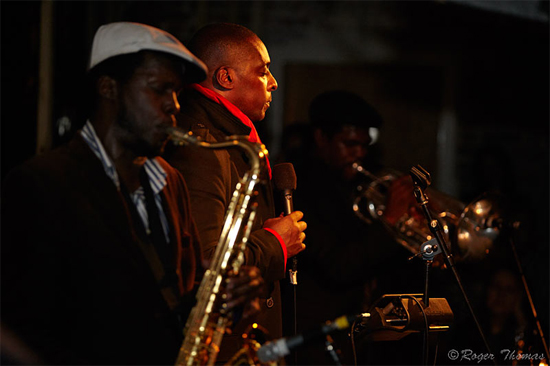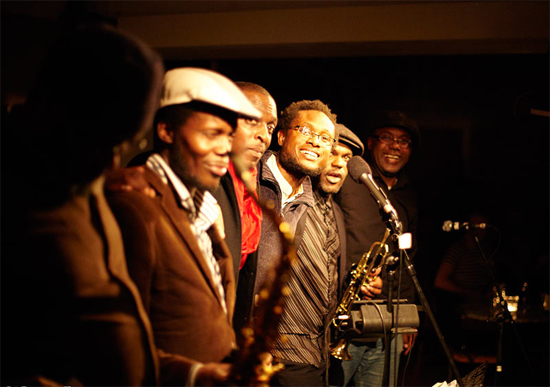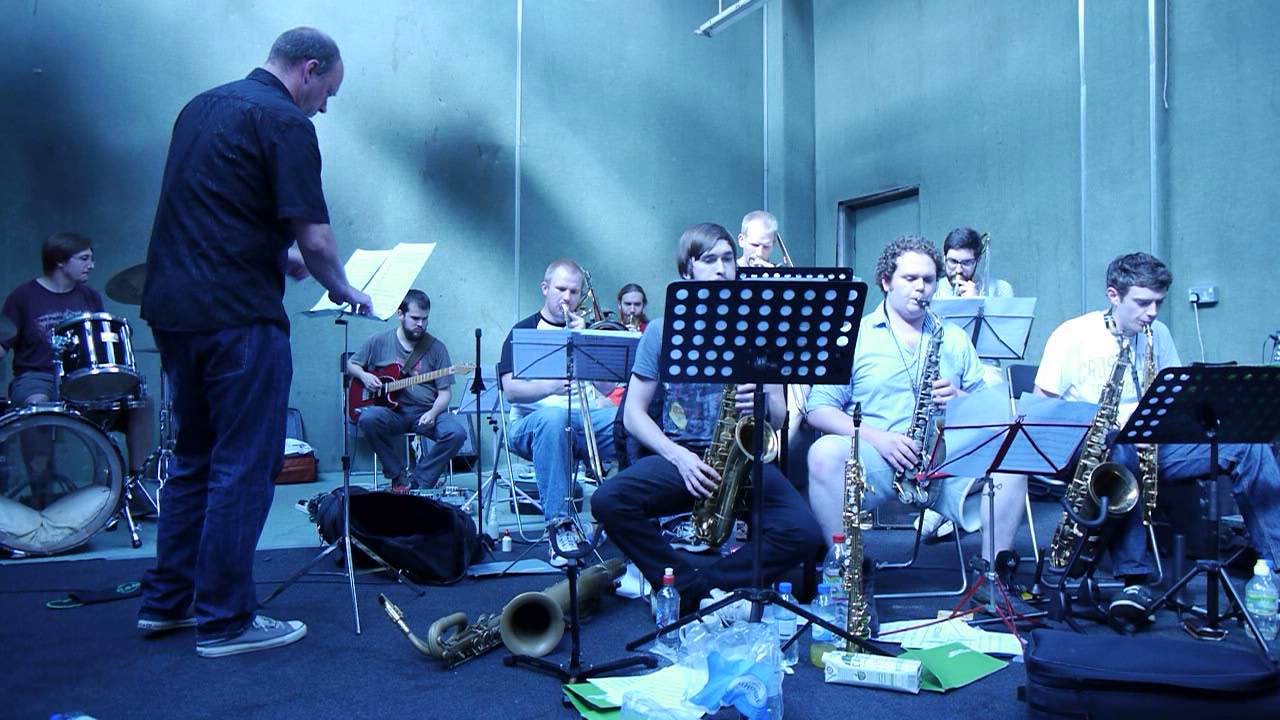Black Top photos courtesy of Roger Thomas
"Don’t worry if your path to jazz is not through a book; find your own way." These were the words of British vibes player Corey Mwamba during a discussion entitled ‘Way In To The Way Out’ on the opening weekend of the London Jazz Festival. It proves to be sage advice as we navigated some of the disparate corners of this year’s programme.
The roots of the LJF reach back to the mid 70’s when the London Borough of Camden added a jazz week to the long established Camden Festival. The Camden Jazz Week grew to embrace the best of British and overseas jazz across multiple venues. With the end of the Camden Festival, promoters Serious launched the inaugural London Jazz Festival in 1992. The plan was to bring together artists from across the world as well as celebrating the cultural and musical diversity of the capital. It’s an ethos that has defined the festival, as it has grown to now feature up to 30 shows a night across the city, in venues ranging from the concert halls of the South Bank and Barbican to a wide range of small club venues, from Vortex to Village Underground.
Our first weekend begins with a collaboration of 21st Century Big Band music from Manchester’s Beats and Pieces and Norway’s Ensemble Denada at the Purcell Rooms. The same afternoon Gabriel Garrick was paying tribute to his late father Michael Garrick’s Big Band at The Spice of Life. But whereas Garrick’s powerful ensemble was very much modelled on the great big bands of old, the collaboration tonight is more contemporary, with electronic effects and scratchy VJ visuals adding an edge. Opening the session are the young Manchester collective led by the effervescent composer and arranger Ben Cottrell. The free yet funky sound brings to mind the Loose Tubes whose impact on British jazz cannot be overstated. The idea behind Ensemble Denada was to achieve small-band dynamics with a large ensemble, and there is a tautness and order to the Norwegians’ sound that contrasts nicely with the looser approach of their UK counterparts. When Cottrell and Helge Sunde swap places to conduct each other’s ensemble with new compositions written by the composers, it’s clear that this is one project making the most of its European cultural funding.
The collaboration is part of the Jazz In The New Europe strand of this year’s festival, which includes sessions by old school players like French jazz bassist Henri Texier and Norway’s scat legend Karin Krog as well as interesting collaborations such as those between Serbian pianist Bojan Z and Bosnian singer Amira. It is also the theme of one of the many talks taking place over the weekend, with a thought provoking discussion between journalists Kevin Le Gendre and Francesco Martinelli alongside Karin Krog.
While Jazz In The New Europe is being celebrated at venues across town, the best of the diverse British scene is also well represented. One of the many clashes over the week saw us miss the great Manchester saxophonist Nat Birchall who along with Matthew Halsall is part of a quiet little movement of spiritual jazz in the North of England. British jazz does provide us with the most creative set of the week however, in the form of the heavy London improv collective Black Top. Originally planned as a trio performance at Café Oto with vibes/steel pan player Orphy Robinson, keyboardist Pat Thomas, and saxophonist Steve Williamson, the collective actually debuted at the Dalston venue as a duet when Thomas had to pull out of the gig. They have since returned to Oto as a trio with trumpeter Byron Wallen, but tonight’s performance of this occasional project promises to be the heaviest yet, with all the aforementioned players alongside ex Metalheadz jazz/improv vocalist Cleveland Watkiss and Corey Mwamba on vibes.
It proves to be an incredibly powerful yet eloquent session, exploring the interaction of live instrumentation and technology in jazz improvisation from a Black British perspective. There is no set plan for tonight; the band relying instead on a freeform intuition gained not only from the members’ grounding in the hugely influential Jazz Warriors but also through their shared Jamaican roots. This foundation in reggae as well as jazz is evident both in the use of echo and effects, but also the ethereal samples of roots classics that permeate the set. This is a band deeply respectful of their heritage, and when Watkiss takes a break from improvising with beat box and electronics, it’s to read a poem from the great British Caribbean trumpeter Shake Keane. When the power of the ensemble subsides after 90 exhilarating minutes, those lucky enough to witness this gathering are left with no doubt that free can also certainly be funky.

Wadada Leo Smith has been fighting for freedom through his music all his life. As a member of the AACM in Chicago in the late 60s he was part of one of the great American jazz co-ops using music as a weapon. Earlier this year the 70-year-old trumpeter, composer and teacher, released Ten Freedom Summer, a four and a half hour long LP dedicated to the civil rights struggles. It was an LP that was three decades in the making, and is evidence of his place as one of the leading voices in free improvisation. So his appearance at Bishopsgate Institute alongside pianist John Tilbury was always going to be one of the most anticipated shows of the week. Split into three sets, the opener sees Smith take to the stage for a solo performance of awe-inspiring weight and clarity. His distorted harmonics and multiphonics are mixed with and a whole range of effects that have the crowd wondering ‘how did he do that?’ After a solo piano set dedicated to an episode of Sherlock Holmes, Tilbury is joined by Smith for a 45 minute attack of free improvisation from two players who continue to explore the possibilities of their instruments.
Another master of his instrument is pianist Marcus Roberts who perhaps inhabits the opposite end of the jazz spectrum to Wadada Leo Smith. But following the onslaught of the previous night we were pleased to be heading for what promised to be a more straight ahead affair, as the ex Marsalis sideman brought his trio to King’s Place. A great pianist full of technical virtuosity, Roberts has sometimes been criticised for his lack of innovation. This is perhaps through his choice of standards and homages to the jazz greats like tonight’s tribute to Thelonius Monk and John Coltrane. Beginning with a strident version of ‘Blue Monk’, Roberts blows that theory out of the water with his boldly adventurous interpretations. Full of invention and verve, his innovative stride piano is matched by the dexterity of bassist Rodney Jordan and the rhythmic pulse of drummer Jason Marsalis. It’s testament to the power of this trio that for the second set they revisit an album from probably the greatest ever quartet. It’s been said that the trio have the ability to sound like more than three instruments. They go some way to proving that tonight with a dazzling interpretation of Crescent that reverberates with much of the spiritual intensity and modal beauty created by John Coltrane, pianist McCoy Tyner, bassist Jimmy Garrison and drummer Elvin Jones nearly 50 years ago now.
At around the same time in the 1960s, over in the UK, other players were also seeking divine inspiration while looking east. Through his exploration of Indian ragas and performances at St Paul’s Cathedral, pianist and composer Michael Garrick, who sadly passed away last year, was responsible for deeply spiritual music that continues to resonate today. But it was his lightness of touch that set him apart; a witty English eccentric as likely to dedicate a suite to Peter Pan as compose towering modal epics like ‘Black Marigolds’ and ‘Dusk Fire’. And it’s this mix of immense emotional power and gentle humour that’s explored on the closing weekend by a band of Garrick associates (including horn player Art Themen and bassist Dave Green) assembled by his musician sons Chris and Gabriel. From a killer version of ‘Black Marigolds’ and a spine tingling take on his pastoral jazz masterpiece ‘The Heart is a Lotus’ (with scat vocalist Jacqui Dankworth) to two numbers featuring the witty tongue of his regular collaborator in Poetry and Jazz Jeremy Robson, it’s an intensely moving and fitting tribute to this most unique and lyrical British jazzman.
A few hours later a similarly influential figure in British jazz, sax powerhouse Larry Stabbins, is threatening to take the roof off the Festival Hall with his post Coltrane jazz collective Stonephace Stabbins. The band was conceived when the ex co-leader of Working Week appeared alongside players like MOBO-winning pianist Zoe Rahman and Galliano percussionist Spry Robinson in Jerry Dammers’ Spatial AKA Orchestra. The spirit and power of that ensemble is carried onto the free stage at the Clore Ballroom on our final night at the festival. Deeply indebted to masters like Coltrane and Pharoah Sanders but played with a maverick London edge, this is a serious trip into the future of spiritual jazz.
It marks a fitting end to our small exploration into the evolution of jazz in the 21st century. While innovations in sound and technology continue to take the music in new directions, the greatest advancements are being made when the traditions of the past are mined to fuel the sounds of the future. And the most forward thing we heard all week? A stomping New Orleans marching tune from the early 1900s, played from a crackly old tape on the fringes of the festival.



